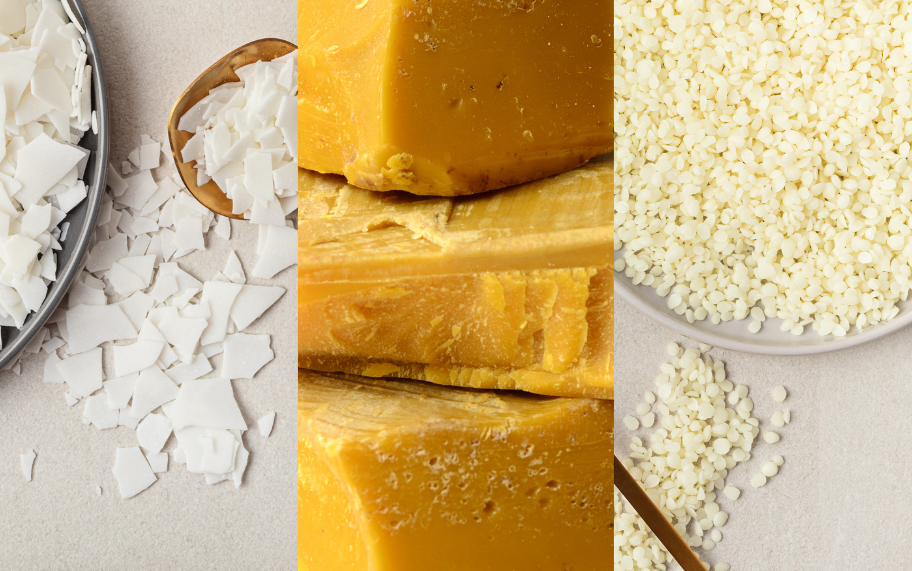Parlons de cire

Un aperçu complet des cires les plus populaires utilisées dans l'industrie des bougies
La cire est l'un des éléments les plus cruciaux d'une bougie. C'est le combustible qui alimente la flamme et maintient la bougie allumée du début à la fin. Sans la cire, une mèche brûlerait en un rien de temps, et à quoi ça sert ?
Techniquement, presque n'importe quel type d'huile peut être transformé en cire, mais certaines huiles sont de meilleurs choix que d’autres en termes d’avantages qu’ils offrent. Il existe un nombre croissant de cires utilisées pour fabriquer des bougies à travers le monde. Nous examinerons ici certains des types de cire de bougie les plus populaires et à quoi elles peuvent être utilisées.
Le soja est devenu l'une des cires les plus populaires utilisées aujourd'hui dans la fabrication de bougies. C'est une cire naturelle, durable et biodégradable. Il est facile à utiliser, ce qui le rend idéal pour les débutants dans le domaine de la fabrication de bougies.
Dans sa forme la plus naturelle, la cire de soja a un point de fusion très bas et est très douce par rapport à d'autres cires comme la cire d'abeille et certaines cires de paraffine. Le soja est donc idéal pour les bougies fabriquées et brûlées dans un récipient. Cela permet également de fondre très facilement. La cire de soja peut même être fondue dans votre micro-ondes.
Le soja offre un bon parfum bien qu'il s'agisse d'une cire plutôt dense. Malheureusement, la densité de la cire aura un effet sur la distance à laquelle le parfum peut être projeté ainsi que sur la durée pendant laquelle le parfum persistera dans l'air. Cela rend une bonne évacuation de l’humidité si importante. Les meilleures mèches à utiliser dans les bougies de soja sont les mèches en coton ou en papier à haute résistance (HTP)
Lorsque le soja pur subit de grands changements de température, comme lorsqu'il fond puis refroidit lors de la création d'une bougie, des cristaux se forment dans toute la cire, donnant une apparence similaire. givrer sur une fenêtre en hiver. Le « glaçage » sera encore plus évident lorsque du colorant est ajouté à la cire. Bien que ces cristaux n'aient pas d'impact négatif sur la façon dont une bougie brûle, ils ont évidemment un impact sur l'esthétique de la bougie.
Au fil des années, les fabricants de cire de soja ont développé de nombreuses formulations différentes pour lutter contre les problèmes tels que le glaçage et les dessus bosses qui sont des désagréments courants lors de l'utilisation de la cire de soja. Il existe sur le marché d’excellents mélanges de cire de soja qui réduisent considérablement les risques que ces problèmes se produisent. Cependant, il est pratiquement impossible de garantir que les additifs empêcheront complètement la cire de soja de faire ce qu'elle fait naturellement.
D'autres mélanges de cire de soja sont devenus disponibles, beaucoup plus durs, ce qui permet également d'utiliser le soja pour des bougies autoportantes telles que des piliers et des votives. Ces mélanges entièrement naturels contiennent d'autres composants botaniques qui les rendent suffisamment durs pour conserver leur forme lorsqu'ils sont retirés d'un moule et lorsqu'ils sont brûlés avec la mèche appropriée.
En raison de la demande et de l'inflation, le prix de l'huile de soja et donc de la cire de soja a considérablement augmenté. Cependant, le soja reste très populaire et constitue une excellente option pour les fabricants de bougies débutants et avancés.
La cire de coco est un choix de plus en plus populaire pour la fabrication de bougies. La cire de noix de coco est dérivée de l'huile de noix de coco pressée à froid, considérée comme une ressource naturelle et renouvelable, ce qui la rend idéale pour les fabricants de bougies soucieux de l'environnement.
La cire de coco a un aspect blanc crémeux qui donne une sensation luxueuse et naturelle aux bougies. Il a également une texture lisse qui permet de créer facilement une surface lisse. La cire de noix de coco a un taux de retrait plus faible, ce qui la rend facile à utiliser lors de la fabrication de bougies en pot, pour lesquelles elle convient le mieux. Il prend très bien la teinture et donne de belles couleurs vibrantes.
Le parfum des bougies en cire de noix de coco est souvent considéré comme supérieur à celui des autres types de cire, permettant une expérience plus luxueuse et aromatique avec vos bougies. En raison de la douceur de la cire de noix de coco, il est courant que les fabricants la mélangent avec d'autres cires comme le soja et la paraffine, ce qui facilite sa transformation en plaques et en granulés. .
Comme la cire de soja, la cire de noix de coco peut être plutôt chère. Cependant, c'est une cire à la mode avec laquelle travailler et la qualité vaut bien son prix.
La cire de paraffine est un choix populaire pour la fabrication de bougies en raison de sa polyvalence et de ses nombreux avantages. Il s'agit d'un sous-produit du raffinage du pétrole brut et est largement disponible, ce qui en fait une option abordable pour de nombreux fabricants de bougies.
Vous pouvez trouver une cire de paraffine qui conviendra à chaque type de bougie, du récipient au votif en passant par le pilier. Il prend exceptionnellement bien la teinture des bougies et produit des couleurs vives époustouflantes. Son parfum est inégalé par tout autre type de cire en raison de la quantité d'huile parfumée qu'elle est capable de contenir ainsi que de sa légèreté. Cela permet au parfum d'être très facilement projeté plus loin et de persister dans l'air plus longtemps que les autres types de cire.
La cire de paraffine a une longue durée de conservation et peut être stockée pendant une période prolongée sans perdre sa qualité. Cela en fait un choix idéal pour ceux qui souhaitent acheter de la cire en gros et la stocker pour une utilisation future.
La cire de paraffine est utilisée par les fabricants de bougies depuis plus d'un siècle et tant qu'il y aura du pétrole brut à raffiner, la cire de paraffine continuera d'être disponible. Cela la rend moins durable que les autres cires. La cire de paraffine n'est pas renouvelable, donc une fois le pétrole brut épuisé, la cire de paraffine aussi.
La cire d'abeille est un excellent choix pour la fabrication de bougies. Il s’agit d’une ressource naturelle et durable produite par les abeilles dans le cadre de leur processus de fabrication du miel. C'est une ressource renouvelable qui peut être récoltée sans nuire aux abeilles ou à leur environnement.
La cire d'abeille est non toxique et est le seul type de cire capable de réellement purifier l'air. Lorsque les bougies en cire d'abeille sont brûlées, elles produisent des ions négatifs qui se lient aux polluants atmosphériques (ions positifs) et les font tomber au sol.
La cire d'abeille est une cire très dure. Cela signifie qu’elle nécessite plus de chaleur que les autres cires plus douces pour la faire fondre. Cela signifie également qu'il se dilatera plus que les autres lorsqu'il fondra et donc rétrécira et se contractera un peu en refroidissant. C'est pourquoi la cire d'abeille est mieux adaptée aux bougies moulées qu'aux bougies en récipient, car elle rétrécira certainement sur les côtés lorsqu'elle sera versée dans un récipient.
La cire d'abeille naturelle est de couleur jaune doré et dégage un délicieux parfum de miel, qui est magnifique mais peut affecter ou limiter vos possibilités lors de l'ajout de parfum et/ou de colorant. De la cire d'abeille blanche, filtrée sur charbon actif pour éliminer la couleur, est également disponible.
La cire d'abeille est une autre cire naturelle qui se situe à l'extrémité la plus chère du spectre. Cependant, la cire d'abeille a de nombreux adeptes qui l'aiment suffisamment pour être prêts à payer le prix supplémentaire pour les bougies fabriquées avec.
La cire de palme est une cire végétale naturelle fabriquée à partir de l'huile de palmier. C'est un choix populaire pour la fabrication de bougies en raison de ses nombreux avantages et de ses propriétés respectueuses de l'environnement.
Les palmiers sont cultivés dans de nombreuses régions tropicales du monde, ce qui fait de l'huile de palme et de la cire de palme une ressource renouvelable. Les palmiers sont connus pour leur rendement élevé, ce qui signifie qu'ils peuvent produire de grandes quantités d'huile sans nécessiter beaucoup de terres ou de ressources.
Les bougies en cire de palme ont une durée de combustion plus longue que les autres types de bougies. En effet, la cire de palme est une cire très dure avec un point de fusion élevé, ce qui signifie qu'elle met plus de temps à brûler.
Il possède également une structure cristalline unique qui lui donne un bel aspect scintillant et plumeux. Lorsqu'il est utilisé dans des bougies moulées, il crée un aspect givré naturel qui est esthétique et ajoute à l'ambiance de n'importe quelle pièce. Vous pouvez également utiliser la cire de palme sous sa forme granulée pour fabriquer des « bougies de sable ». Les granulés peuvent être teints à l'aide d'un colorant liquide pour bougie, puis superposés stratégiquement dans un récipient transparent pour créer de superbes designs.
Conclusion
En conclusion, il existe une variété de types de cire disponibles pour la fabrication de bougies, chacun ayant ses avantages et ses caractéristiques uniques. La cire de soja, la cire de noix de coco, la cire de paraffine, la cire d'abeille et la cire de palme font partie des types de cire les plus couramment utilisés pour la fabrication de bougies.
La cire de soja et la cire de noix de coco sont d'excellents choix pour ceux qui recherchent un produit durable et renouvelable.option. La cire de paraffine est largement utilisée en raison de son prix abordable et de sa polyvalence. La cire d'abeille offre une option naturelle et respectueuse de l'environnement, tandis que la cire de palme offre une superbe finition cristalline.
En fin de compte, le type de cire que vous choisirez pour votre projet de fabrication de bougies dépendra de vos préférences, de votre budget et de vos besoins spécifiques. Quelle que soit la cire que vous choisissez, avec les techniques et les outils appropriés, vous pouvez créer de belles bougies durables qui remplissent votre maison de chaleur et de parfum.
Huiles parfumées et produits de santé Nos huiles parfumées sont destinées pour usage externe dans les bougies, les diffuseurs et certaines applications cosmétiques. Ils ne doivent pas être ingérés, inhalés ou appliqués directement sur la peau sans dilution appropriée. Santé Canada exige un numéro de produit naturel (NPN) pour la vente de tout produit faisant des allégations santé ou destiné à un usage thérapeutique. Il est de votre responsabilité de vous assurer que la formulation de votre produit final est conforme à toutes les réglementations applicables et qu'elle obtient la certification NPN nécessaire avant la vente.
Les huiles parfumées, lorsqu'elles sont incorporées dans des produits de santé, peuvent nécessiter des tests de sécurité supplémentaires pour garantir leur adéquation et leur interaction avec d’autres ingrédients. Nous vous recommandons fortement d'effectuer des tests indépendants par un laboratoire qualifié pour confirmer la sécurité et l'efficacité de la formulation de votre produit final. En achetant ce produit, vous acceptez d'assumer l'entière responsabilité de sa bonne utilisation et application. Nous ne pourrons être tenus responsables de toute mauvaise utilisation, réclamation ou dommage résultant de l’utilisation de cette huile parfumée dans un produit de santé.





